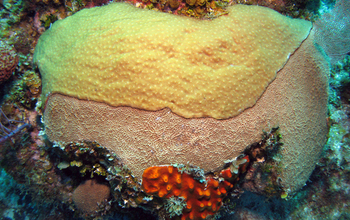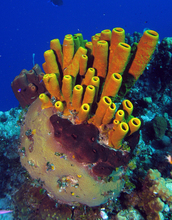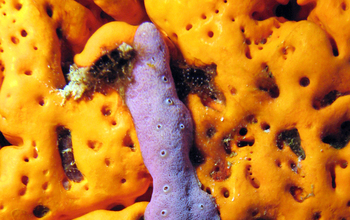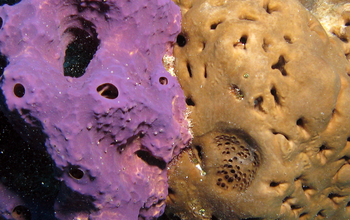All Images
News Release 14-025
Overfishing of Caribbean coral reefs favors coral-killing sponges
Caribbean-wide study shows protected coral reefs dominated by sponges with chemical defenses
This material is available primarily for archival purposes. Telephone numbers or other contact information may be out of date; please see current contact information at media contacts.

A sponge smothers a living coral head on a reef that lacks predatory angelfish.
Credit: Joe Pawlik, UNCW
Download the high-resolution JPG version of the image. (6.9 MB)
Use your mouse to right-click (Mac users may need to Ctrl-click) the link above and choose the option that will save the file or target to your computer.

More than five species of sponges cover a coral reef in the Bahamas.
Credit: Joe Pawlik, UNCW
Download the high-resolution JPG version of the image. (5.1 MB)
Use your mouse to right-click (Mac users may need to Ctrl-click) the link above and choose the option that will save the file or target to your computer.

Aplysina cauliformis (violet) on Agelas clathrodes (orange); both carry potent chemicals.
Credit: Joe Pawlik, UNCW
Download the high-resolution JPG version of the image. (3.1 MB)
Use your mouse to right-click (Mac users may need to Ctrl-click) the link above and choose the option that will save the file or target to your computer.

Large chemically-defended sponges on a reef with abundant sponge-eating fish in the Bahamas.
Credit: Joe Pawlik, UNCW
Download the high-resolution JPG version of the image. (6.0 MB)
Use your mouse to right-click (Mac users may need to Ctrl-click) the link above and choose the option that will save the file or target to your computer.

A yellow burrowing sponge attacking a plate-forming stony coral.
Credit: Joe Pawlik, UNCW
Download the high-resolution JPG version of the image. (7.8 MB)
Use your mouse to right-click (Mac users may need to Ctrl-click) the link above and choose the option that will save the file or target to your computer.

Close-up of the brilliantly-colored Ailochroia crassa (purple) and Agelas sp. (brown).
Credit: Joe Pawlik, UNCW
Download the high-resolution JPG version of the image. (1.9 MB)
Use your mouse to right-click (Mac users may need to Ctrl-click) the link above and choose the option that will save the file or target to your computer.


